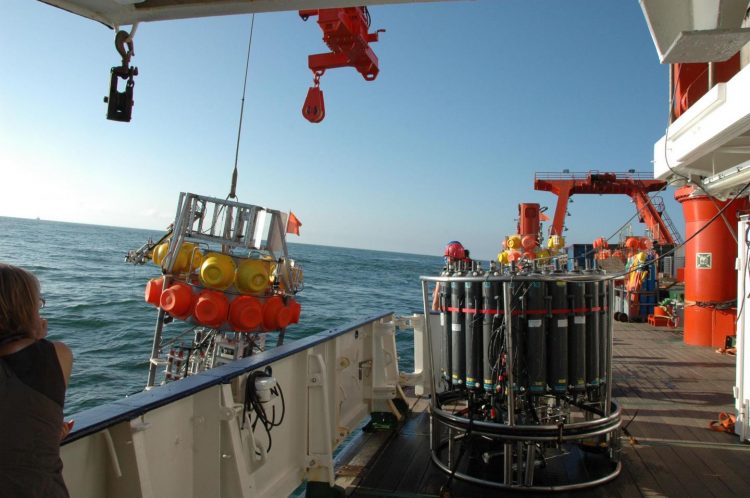Conundrum of missing iron in oxygen minimum zones solved

During the expedition M92 samples and data from the seafloor and from the water column of the oxygen minimum zone off Peru were obtained using various devices. Credit: Michael Schneider, FS METEOR
In principle, there is no lack of iron on Earth as the metal is one of the most abundant elements in the Earth's crust. However in the ocean, dissolved iron is very rare, since it reacts rapidly with oxygen forming iron minerals which are poorly soluble and therefore unavailable for organisms.
Nevertheless, dissolved iron is an essential nutrient for life. Without iron there would be no plankton growth, no food chain, no photosynthesis and no carbon fixation in the oceans. The sources of this micronutrients is therefore a central question for marine research. In theory, plenty of dissolved iron should be present in low-oxygen areas because there the reaction partner oxygen is missing. However, measurements show that this is not the case even in the large and essentially anoxic oxygen minimum zones of the tropical oceans.
An international research team lead by scientists from GEOMAR Helmholtz Centre for Ocean Re-search Kiel carried out a complex interdisciplinary study in the context of the Collaborative Re-search Project (SFB) 754 “Climate-Biogeochemistry Interactions in the Tropical Ocean” and dis-covered a process which explains the iron removal under anoxic conditions. “The results can also help to understand fundamental processes in the nitrogen and the carbon cycle”, explains Dr. Flo-rian Scholz from GEOMAR. He is the first author of the study, which has recently been published in the international journal Earth and Planetary Science Letters.
The conundrum about the relative “iron deficiency” in the tropical oxygen minimum zones was even greater since previous studies had shown that in these regions huge amounts of iron are released in the ocean from anoxic sea floor sediments. “However, only a small part of this iron reaches the surface layers and the open ocean where biological productivity is limited by iron”, Florian Scholz explains. Thus, the question was: Which process is removing the iron from the seawater?
In order to solve this question, the team took samples from the seabed, from the boundary layer between the seabed and seawater, as well as from different water layers in the tropical oxygen minimum zone during the Expedition M92 with the German research vessel METEOR in January 2013. These samples were then extensively investigated for chemical, physical and biological parameters.
“Among other tasks microbiologists carried out genetic analyses of the microorganisms living in the water in order to evaluate which metabolic processes are predominant”, Scholz explains. In addition, the team studied particle samples from the water column at the synchrotron radiation source at the Karlsruhe Institute of Technology (KIT). With this analysis they were able to determine which iron minerals occur in the different water layers.
These analyses revealed that the iron reacts with nitrate instead of oxygen. This is due to certain microorganisms, which are also responsible for the decomposition of bioavailable nitrogen. “So far, these processes have not been detected in oxygen minimum zones”, Florian Scholz explains, “but they are important to understand the overall system. Only when we know when and where certain nutrients are available for plankton growth we can also estimate how much carbon the plankton can bind by photosynthesis and thus remove from the atmosphere”.
As head of a new Emmy Noether junior research group funded by the German Science Foundation, Dr. Florian Scholz will continue to study the fluxes of iron and other micronutrients across the seafloor in the coming years. “At present, we are further developing existing, autonomous deep-sea laboratories such that they can also detect very small concentrations of certain trace elements, such as iron. Yet, we do not fully understand the circumstances under which seafloor sediments represent a source or a sink for these essential elements”, emphasizes the biogeochemist.
Media Contact
All latest news from the category: Life Sciences and Chemistry
Articles and reports from the Life Sciences and chemistry area deal with applied and basic research into modern biology, chemistry and human medicine.
Valuable information can be found on a range of life sciences fields including bacteriology, biochemistry, bionics, bioinformatics, biophysics, biotechnology, genetics, geobotany, human biology, marine biology, microbiology, molecular biology, cellular biology, zoology, bioinorganic chemistry, microchemistry and environmental chemistry.
Newest articles

First-of-its-kind study uses remote sensing to monitor plastic debris in rivers and lakes
Remote sensing creates a cost-effective solution to monitoring plastic pollution. A first-of-its-kind study from researchers at the University of Minnesota Twin Cities shows how remote sensing can help monitor and…

Laser-based artificial neuron mimics nerve cell functions at lightning speed
With a processing speed a billion times faster than nature, chip-based laser neuron could help advance AI tasks such as pattern recognition and sequence prediction. Researchers have developed a laser-based…

Optimising the processing of plastic waste
Just one look in the yellow bin reveals a colourful jumble of different types of plastic. However, the purer and more uniform plastic waste is, the easier it is to…



